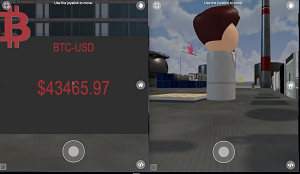News
Microverse IDE Unveiled for Web3 Developers, Metaverse Projects
As the Metaverse, Web3 and associated technologies take shape, developer tooling is arriving to help give it structure.
The latest example of that is an open beta program for the new Microverse IDE from Croquet Corp., which works with the company's own Croquet OS to help web and Web3 developers create interoperable, standards-based Metaverse worlds. Wikipedia describes Web3 as the "concept of a World Wide Web based on public blockchains."
The company positions its Croquet OS as a web-standards-based OS that is crucial to its mission of building an open, democratized Metaverse, which Wikipedia defines as a futuristic term associated with the internet being a single, universal and immersive virtual world that is facilitated by the use of virtual reality (VR) and augmented reality (AR) headsets. In more modern colloquial use, however, it's described as a network of 3D virtual worlds focused on social connection.
"With Microverse IDE, developers and designers collaboratively build low-latency, high-performance multiuser Microverse spaces and worlds which can then be published anywhere," the company said in a June 21 news release. As part of its Multiverse democratization effort, Croquet has open sourced its Microverse IDE Metaverse world builder and some related components under the Apache License Version 2.0 license so developers and adopters can examine, use and modify the software as needed.
 [Click on image for larger view.] Coding in Microverse (source: Croquet).
[Click on image for larger view.] Coding in Microverse (source: Croquet).
The Los Angeles-based company claims Croquet OS is the only open, browser-based OS that unites the web and the Metaverse, loading instantly from any URL or QR code during entry to a virtual world with web, mobile or AR/VR devices. "It uses synchronization, live data and persistence services from its globally deployed Croquet Reflector Network to enable ultra low-latency, low-bandwidth shared experiences," the company said. "Any Metaverse developer can integrate Croquet OS as infrastructure to enable multiuser shared experiences and achieve perfectly synchronized shared social interactions."
The California-based Croquet also announced the availability of its multiplane portal technology, used to securely connect independent 3D virtual worlds developed by different parties, effectively creating the Metaverse from independent microservices. These connections can even span different domains, the company said, thus providing safe, secure and decentralized interoperability among various worlds independent of the large technology platforms.
"Multiplane portals solve a fundamental problem in the Metaverse with linking web-based worlds in a secure and safe way," the company said. "Interoperability is one of the core underlying requirements of an open Metaverse and the Croquet solution, based upon open, standards based technologies, provides a global solution for developers and companies who desire independence from the proprietary networks."
The new multiplane tech is the subject of a long, detailed Twitter thread started by the company's David A. Smith, who said, "Multiplane portals solve a fundamental problem with linking web-based worlds in a secure and safe way. The ability to move freely and easily between the billions of virtual worlds in our future is a central pillar to the definition of the Metaverse."
Croquet will also release an API and framework to enable portals between all web-based Metaverse worlds, even if they weren't created using the Microverse IDE. "Any developer will be able to utilize multiplane portals to link their worlds to any others that support the new multiplane portal framework, which operates within existing standards and will continue to be developed following collaborative discussion with the community," the company said.
As far as nuts-and-bolts coding within Microverse, the IDE is built around three primary concepts:
- Cards: Every object in a Croquet Microverse is a card. Cards can be constructed by simply dropping an SVG or 3D model into the world. Cards can be grouped together into decks, where each card provides a unique capability.
- Behaviors: These define how the card acts when a user or another card interacts with it. Behaviors computation is replicated on all user systems, providing a perfect, bit-identical shared experience.
- Connectors: Enable cards to access external data streams that can then be displayed in all participating systems in a session.
"By open-sourcing our Microverse IDE we give developers the utmost flexibility in realizing their own dreams for the Metaverse," said Dr. Vanessa Freudenberg, chief architect of Croquet. "In their Microverse they have complete control of the world mechanics, without having to implement, deploy, or maintain their own interaction servers to make it multiuser. We believe that an open source model will be a powerful force to build a free and open ecosystem for the Metaverse."
Developers can download the Microverse open beta here. Croquet OS pricing will be finalized when the IDE reaches General Availability. In addition to the Microverse IDE and Croquet OS, the company offers a Mediaverse Kit (for synchronizing media) and Croquet Reflection Network for ultra low latency with public or private edge and 5G networks.
About the Author
David Ramel is an editor and writer at Converge 360.